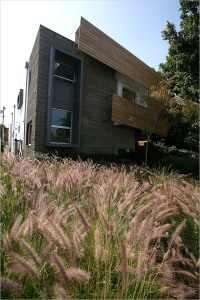You have to wonder about the value of a LEED Platinum certification. This seems to be what happens when commercial architects decide to design a home. It isn’t that I am jaded… well I guess I am. Too many drawings like this have come across my desk. When I point out that the insulation has been drawn backwards, or question the intelligence of a California Contemporary (glass box) in our climate (MN) I get the “look of reproach”. Of course what would us residential guys know. Commercial is king!
This house was recently featured in the NY Times. Lets look at some of the issues with this home.
Exposed on Four sides. This house does not consider the environment it has been placed in. Rather, it has come from the architects desk and been plopped down on some land.
No overhangs. There is no consideration for the protection of the home from the elements. In fact it appears that in an effort to break up the box-nature of the design horizontal projections were added mid-wall.
Unless we are looking at the North and East elevations in this picture there is little to no consideration for natural light and possible passive solar.
Decorative Wood Element. At first I thought this might be a solar shade for the West elevation, but looking closer it seems both unlikely that this is the West side and that it is shadding anything at the top of the building. I would be curious to see how this element fairs over the next 40 to 80 years.
There is a visually interesting detail that sticks out around the window. What I struggle with is the functionality of such a detail. Homes are built for people who know nothing about them, and who value price over quality. In order to maintain the integrity of this detail it will need to be inspected and repaired on a semi-routine basis. That is not practical in this country.
Aesthetics are important, but durability is also important. I wish that we would see more from those with the skills to do better when it comes to residential Green building. Detail the home to function in the climate it will live in, detail the home to blend in with its surroundings, detail the elements of Green building that matter most and cut back on all that fixed glass!
